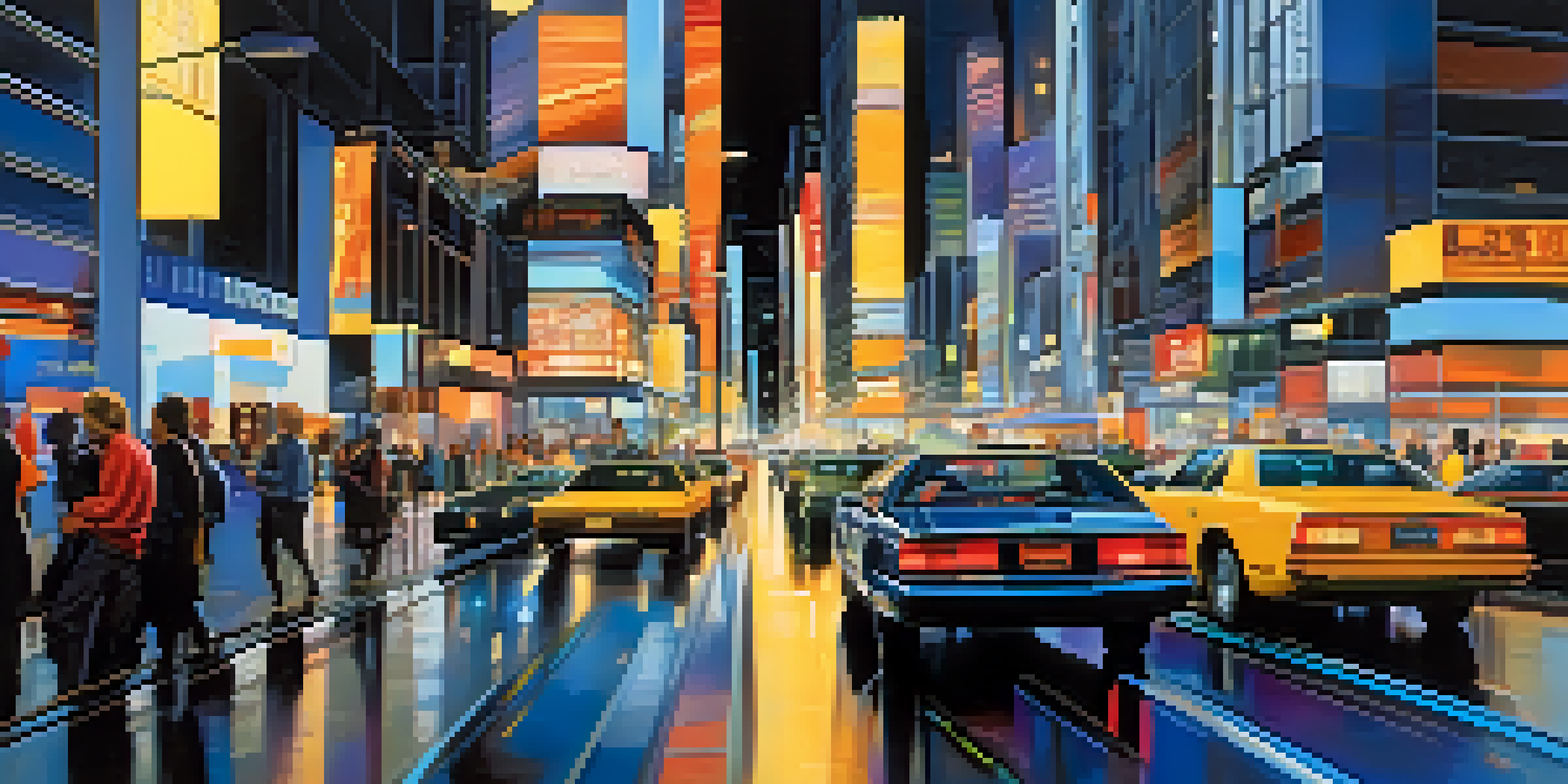Futurism and Its Manifesto: Defining Modern Art

Understanding Futurism: A New Artistic Movement
Futurism emerged in the early 20th century as a bold response to traditional art forms. It celebrated speed, technology, and the energy of modern life, reflecting the rapid changes of the industrial era. Artists sought to break free from the past, embracing innovation and the vibrancy of the new age.
Art can be nothing but violence, cruelty, and injustice.
The movement was formally launched with the Futurist Manifesto, written by the Italian poet Filippo Tommaso Marinetti in 1909. This manifesto proclaimed the importance of dynamism and the glorification of the machine, inviting artists to capture the essence of movement and progress in their work. It was a radical departure from the stillness of classical art.
Through vibrant colors and dynamic compositions, Futurist artists aimed to convey a sense of motion and urgency. They believed that art should reflect the fast-paced world around them, making it incredibly relevant to the modern human experience. The influence of Futurism can still be seen in contemporary art today.
The Futurist Manifesto: Key Themes and Ideas
The Futurist Manifesto is a cornerstone document that outlines the core beliefs of the movement. It boldly declares that artists should embrace modernity, rejecting the past and celebrating the future. Themes of speed, technology, and violence are prevalent, emphasizing a break from traditional aesthetics.

Marinetti's manifesto provoked thought and discussion, claiming that 'art can be nothing but violence, cruelty, and injustice.' This radical approach sparked both admiration and criticism, challenging artists and audiences to rethink their relationship with art and society. It encouraged a new way of seeing the world.
Futurism: A Bold Artistic Movement
Emerging in the early 20th century, Futurism celebrated speed and technology, reflecting the dynamic changes of the industrial era.
The manifesto also called for the destruction of museums and libraries, critiquing these institutions as symbols of stagnation. Instead, it urged artists to create works that embody the energy of contemporary life. This revolutionary spirit inspired many artists to experiment and push boundaries, resulting in a diverse array of artworks.
Futurism in Visual Arts: Notable Artists and Works
Futurism attracted a range of talented artists, each bringing their unique vision to the movement. Artists like Umberto Boccioni and Giacomo Balla became known for their innovative techniques and captivating portrayals of motion. Boccioni's work 'Unique Forms of Continuity in Space' exemplifies the Futurist aim to capture dynamic movement through sculpture.
We will glorify war—the world's only hygiene—militarism, patriotism, the destructive gesture of freedom-bringers, beautiful ideas worth dying for, and scorn for women.
Another key figure, Balla, explored the concept of light and color with his painting 'Dynamism of a Dog on a Leash.' This piece illustrates the rapid movement of a dog and its owner, using blurred lines to convey speed. Such works challenged viewers to experience art in a new, visceral way.
Futurism also extended beyond painting and sculpture, influencing other art forms like literature and architecture. The movement's emphasis on modernity and innovation resonated across various disciplines, creating a lasting legacy that continues to inspire artists today.
The Role of Technology in Futurism
Technology played a pivotal role in shaping the Futurist movement. With the advent of the industrial revolution, artists were fascinated by machines, speed, and the possibilities of modern engineering. They viewed technology as a symbol of progress and a means to express the frenetic energy of contemporary life.
Futurist artists often incorporated themes of machinery into their work, celebrating the beauty of industrial landscapes and the dynamism of urban life. This fascination was not merely aesthetic; it also reflected a deeper belief in the transformative power of technology to change society for the better.
The Radical Futurist Manifesto
Filippo Tommaso Marinetti's manifesto urged artists to reject tradition and embrace modernity, emphasizing themes of speed, technology, and a break from the past.
As a result, artworks from this period often depicted trains, cars, and factories, showcasing the excitement and potential of the modern world. These representations encouraged viewers to embrace the future, ultimately redefining how they viewed both art and technology.
Futurism's Manifesto and the Philosophy of Art
At its core, the Futurist Manifesto challenged the very philosophy of art itself. It posited that art should not only represent reality but also actively engage with and transform it. This idea was revolutionary in a time when art was often seen as a reflection of beauty and tradition.
Futurism’s philosophy emphasized the need for art to be dynamic, reflecting the chaos and energy of modern life. Artists were encouraged to experiment with form and technique, pushing the boundaries of what art could be. This led to innovative styles that broke away from convention, such as abstract and collage techniques.
By redefining the purpose of art, Futurism opened the door for future movements like Cubism and Constructivism. Its impact on modern art is undeniable, and the dialogue it initiated about the role of art in society continues to resonate with artists and thinkers today.
The Decline of Futurism: Historical Context
Despite its initial fervor, Futurism began to decline in the 1920s, partly due to the political climate in Italy. The rise of Fascism, which some Futurist artists supported, complicated the movement's legacy. As the political landscape shifted, the ideals of Futurism became intertwined with nationalism, leading to a reevaluation of its principles.
Additionally, the horrors of World War I prompted a backlash against the exuberance celebrated by Futurism. Artists began to question the glorification of violence and technology, leading to a shift towards more introspective and critical forms of art. The movement that once celebrated the future now faced disillusionment.
Futurism's Lasting Influence
Despite its decline, Futurism's emphasis on innovation continues to inspire contemporary artists and provoke discussions about art and technology.
As the 20th century progressed, other artistic movements emerged, overshadowing Futurism. However, its influence persisted, laying the groundwork for later avant-garde movements. Futurism's legacy is complex, reflecting both its radical beginnings and the contradictions that arose as the world changed.
Futurism's Lasting Impact on Modern Art
Futurism's impact on modern art is profound and far-reaching. Its emphasis on innovation and rejection of the past has inspired countless artists across various disciplines. The movement's spirit of experimentation can be seen in contemporary art, where boundaries are continually pushed.
Moreover, the ideas articulated in the Futurist Manifesto continue to resonate today, encouraging artists to explore the relationship between technology and society. As we navigate an increasingly digital world, the questions raised by Futurism about progress and modernity remain relevant.

In many ways, Futurism paved the way for postmodern art, which often challenges traditional narratives and embraces ambiguity. Its legacy is a reminder of the power of art to reflect and shape the world, inviting us to engage with the complexities of our modern existence.